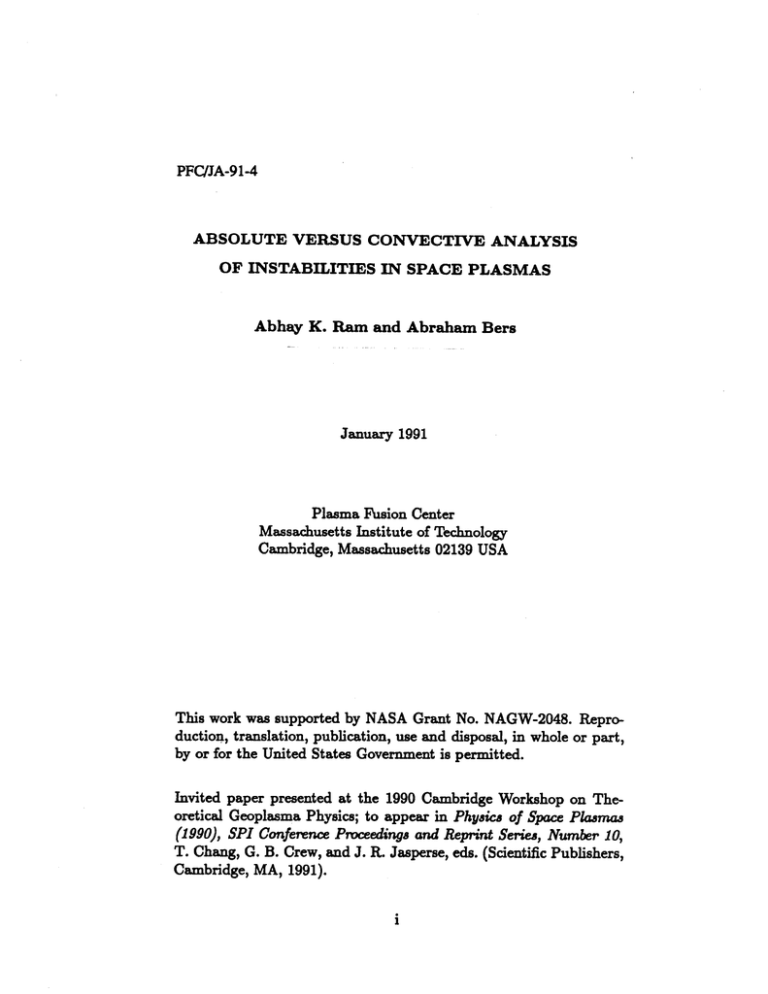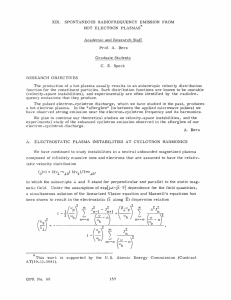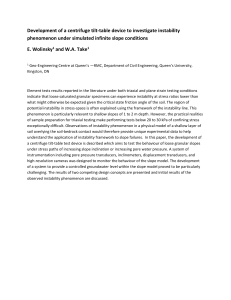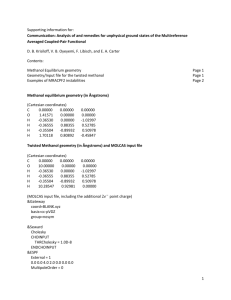PFC/JA-91-4 ABSOLUTE VERSUS SPACE PLASMAS
advertisement

PFC/JA-91-4
ABSOLUTE VERSUS CONVECTIVE ANALYSIS
OF INSTABILITIES IN SPACE PLASMAS
Abhay K. Ram and Abraham Bers
January 1991
Plasma Fusion Center
Massachusetts Institute of Technology
Cambridge, Massachusetts 02139 USA
This work was supported by NASA Grant No. NAGW-2048. Reproduction, translation, publication, use and disposal, in whole or part,
by or for the United States Government is permitted.
Invited paper presented at the 1990 Cambridge Workshop on Theoretical Geoplasma Physics; to appear in Physics of Space Plasmas
(1990), SPI Conference Proceedings and Reprint Series, Number 10,
T. Chang, G. B. Crew, and J. R. Jasperse, eds. (Scientific Publishers,
Cambridge, MA, 1991).
i
ABSOLUTE VERSUS CONVECTIVE ANALYSIS
OF INSTABILITIES IN SPACE PLASMAS
Abhay K. Ram and Abraham Bers
TABLE OF CONTENTS
ABSTRACT . . . . . . . . . . . . ..
. . . . . . . . . . . . . . . . . .
1
INTRODUCTION ...........
.............................
1
GREEN'S FUNCTION ANALYSIS OF INSTABILITIES .....
SPACE-TIME EVOLUTION OF
CYCLOTRON MASER TYPE OF INSTABILITIES
CONCLUSIONS
.........
2
..............
..............................
ACKNOWLEDGEMENTS ..........
............
6
14
..
..........................
15
.
REFERENCES ..............................
ii
16
ABSTRACT
A brief description of the pinch-point analysis of the Green's function for studying the
space-time evolution of instabilities in a homogeneous medium is presented. This analysis
determines if an instability propagates in space-time as an absolute instability or as a convective instability. The pinch-point technique is applied to the study of electron cyclotron
maser type of instabilities. Such instabilities are believed to be a source of some types
of observed planetary, solar and stellar emissions, and, in particular, of auroral kilometric
radiation. The pinch-point analysis also brings out the spectral differences between absolute and convective instabilities that should be important in correlating theoretical models
with observations.
iii
ABSOLUTE VERSUS CONVECTIVE ANALYSIS
OF INSTABILITIES IN SPACE PLASMAS
Abhay K. Ram and Abraham Bers
Plasma Fusion Center, M.I.T., Cambridge, MA 02139
ABSTRACT
A brief description of the pinch-point analysis of the Green's function
for studying the space-time evolution of instabilities in a homogeneous
medium is presented. This analysis determines if an instability propagates
in space-time as an absolute instability or as a convective instability. The
pinch-point technique is applied to the study of electron cyclotron maser
type of instabilities. Such instabilities are believed to be a source of some
types of observed planetary, solar and stellar emissions, and, in particular,
of auroral kilometric radiation. The pinch-point analysis also brings out
the spectral differences between absolute and convective instabilities that
should be important in correlating theoretical models with observations.
I. INTRODUCTION
Laboratory, Space, and Astrophysical plasmas are rich sources of electromagnetic radiation whose intensities are above the thermal levels of
emission. There are two generic ways of generating this radiation. The
first is due to some internal sources of free energy which excite, from noise,
an instability inside the plasma. This occurs, for instance, due to spatial
gradients or anisotropies inherent in the plasma. The second way that the
plasma acts as a source of electromagnetic radiation is by stimulated scattering of some of the externally incident electromagnetic waves. This may
happen when the incident waves couple nonlinearly to some normal modes
of the plasma and unstably drive, from noise, the scattered radiation from
inside the plasma. In either case, the instability evolves in the free energy
source region leading, eventually, to electromagnetic radiation propagating
out of the plasma.
An aspect of the radiation that is observed and measured by a detector or a probe, located in the source region or far away from it, is the
intensity of the emission as a function of either the frequency or the wavelength of the emission. In order to understand the emission, one would
like to know about the onset of the instability that leads to the observed
emission, the propagation in space and time of the instability through the
source region and beyond, and, finally, the evolution towards the saturated
nonlinear state which is eventually observed. In this paper we are going to
1
discuss features of the linear evolution and propagation of instabilities in
a homogeneous medium that would have distinguishable signatures in the
observed spectra.
The linear evolution and propagation of instabilities in a homogeneous
medium has been discussed before [1] . The essence of the Green's function
technique used in these studies is presented in section II. In section III
this technique is applied to the propagation of cyclotron maser type of
instabilities. Such instabilities are considered to be a source of auroral
kilometric radiation [2, 3]. The characteristic features associated with the
propagation of such instabilities through space and time are also discussed
in section III.
II. GREEN'S FUNCTION ANALYSIS OF INSTABILITIES
The propagation of a small amplitude signal in a homogeneous medium
is described by an equation of the form:
(,t
r
dar'
dt' V_(r- - 2', t - t') -j(r"*, t') + s,,,(V 0) (1)
where Z is a linear operator, j is a vector function describing the small
amplitude signal, M describes the medium through which the signal is
propagating, and S.,, is either a noise source or an external source acting
on the medium. The space-time Fourier transform of the above equation
yields:
U(, )-
(, w)=
,,W)
(2)
where D is a sum of the Fourier transform of the left-hand side of Eq. (1)
and the Fourier transform of M. If, for some real-k, the corresponding w's
satisfying det {D(kw)I = D(k,w) = 0 (where det denotes the determinant) are such that the imaginary part of w is > 0, then the medium is
considered to be unstable to a perturbation with that particular k and w.
Eq. (2) can be solved for (k,w), so that the solution to Eq. (1) is given
by:
I(i 't)
=
do dsk
S20
(2r)
D,&(CU
)-,, ev w)
k
it
3
exp(ik.9-iwt)
(3)
D(kjW)
(2F
where D
is the adjoint matrix of D, and L and F are the appropriate
Laplace and Fourier contours of integration, respectively, which are chosen
to satisfy causality [1].
2
While Eq. (3) gives the general space-time propagation of a signal in a
medium driven by ,,,,we are usually interested in the natural response of
the medium. The Green's function technique gives a physical and general
insight into the response properties of the medium [4]. The Green's function
solution, d(9, t), is obtained by replacing §,,, in Eq. (1) by 6(i)6(t)I, where
I is the identity tensor. The Green's function approach is equivalent to
evaluating the response of the medium to a localized, broadband, "white"
noise source. The response to a general perturbation is then obtained by
convolving the Green's function with the perturbation [4].
In what follows, we shall consider scalar fields, b, and only one spatial
dimension. For this case the Green's function is given by:
G(z, t) =
2
J0
20 D(k, w) exp(ikz - iwt)
(4)
where k is the wave-number in the z direction. The generalization to vector
fields and higher spatial dimensions is more complicated but can be carried
out in a straightforward manner.
Even for simple dispersion functions, D(k, w), it is frequently difficult
to compute the Green's function analytically. However, we are not generally
interested in the transient solution to G(z, t). Rather, we would like to
know the time-asymptotic behavior of G(z, t). It has been determined
that, in an unstable medium, the time-asymptotic evolution of G(z, t) can
belong to one of only two possible categories [5, 6]:
(a) an absolute instability,where the response grows in time and encompasses more and more of the space as a function of time - the response
always including the spatial location of the initial perturbation; thus,
every spatial point eventually becoming unstable;
(b) a convective instability, where the response grows in time but propagates away from its point of origin; thus, any spatial point eventually
becoming stable.
While the above classification of the time-asymptotic Green's function into
two categories for an unstable medium is useful, it still leaves us with the
daunting task of solving for G(z, t) in the time-asymptotic limit. This task
was considerably simplified by the "pinch-point" formalism that was originally put forth by Bers and Briggs [6, 7]. This formalism presented a
convenient way to determine whether an unstable medium was absolutely
unstable or convectively unstable, and, furthermore, completely determined
the time-asymptotic Green's function. According to the pinch-point procedure, the time-asymptotic Green's function is completely determined by
those k., w. which satisfy:
D(k,,w.) = 0 '
OD(kIw
Ok
3
=0
(5)
and are "pinch points". A pinch point is determined by the analytic continuation, in the complex w-plane, of the Laplace contour, L, towards the
real w-axis [1, 7]. As L is lowered towards the real w-axis the corresponding
Fourier contour, F, is subsequently modified to satisfy causality. This is
ensured by requiring that F does not intersect any branches obtained by
the mapping of the L-contour into the complex k-plane through the dispersion relation: D(k,w) = 0. This condition is violated when two branches
of the L-contour in the complex k-plane coming from opposite sides of the
real k-axis meet and "pinch" the Fourier contour. This defines the pinch
point in the complex k-plane and it requires that the Laplace contour be
deformed past the corresponding (branch) point in the complex w-plane
(satisfying D(k, w) = 0). If a pinch point exists, and the corresponding
point in w is in the upper half plane at w = w., then the medium is absolutely unstable with the time-asymptotic form of the Green's function
given by:
lim G(Z, t)
~
exp(-iwt)
(6)
Otherwise, the medium is convectively unstable.
The time-asymptotic form of G(z,t) at the origin of the laboratory
coordinate system (z = 0) is given by Eq. (6). The spatial form of G(z, t)
is obtained by doing the pinch-point analysis in all possible inertial frames
which are moving with respect to the laboratory frame [6, 8]. In an inertial
frame moving with velocity v with respect to the laboratory frame, the
Green's function is given by:
G(z', t')
=
I'lfS27r
1
27r
D. (k, , ,v)
exp(ik'z'
-
iw't')
(7)
where the primed quantities are evaluated in the moving frame. D, is given
by:
D,(k', w',v) = D [k(k',w', v),w(k', w',v)]
(8)
and the relation between the primed and the unprimed quantities is given
by the Lorentz transformations:
Z = y (Z' + Wt') ,
k = Y, (k' +2
t = Y ( I, + j Z 'I ,
w=,(w'+ Vk')
' ,
where -y, = (1 - v 2 /c 2 )-1/ 2 .
4
9
Then, as in Eq. (6), the time-asymptotic response of G(z',t') at the
origin of the primed coordinate system is:
lim G(z',t')
(t')l/ 2
exp{-w',(v)t'}
(10)
where the pinch point frequency in the primed coordinate system, w'(v), is
a function of the observer velocity. By using the transformation equations
given in Eq. (9) it is easy to show that:
lim G(z, t)
t-+00
....
t
~
"I
7 )I
t
expf -i
tj
(11)
l,
Besides determining the spatial and temporal evolution of G(z, t) in
the time-asymptotic limit for an absolute instability, it is clear that this
procedure also determines the spatial and temporal evolution of a convective instability.
Thus, from the pinch-point analysis the following properties of an unstable medium can be determined:
(a) the absolute versus convective nature of the unstable medium;
(b) the space-time evolution (i.e. the spatial and temporal growth rates)
of a localized (at z = 0) noise source from an initial time to a time
where the transient response of the system to the initial perturbations
can be ignored;
(c) the velocity of propagation of the instability in the medium.
This last point is very important. In general, the velocity of propagation
is not related to a group velocity of any mode satisfying the dispersion
relation D(k,w) = 0. In particular, for an absolutely unstable medium
the concept of a group velocity cannot be defined. Thus, ray-tracing in an
absolutely unstable medium is meaningless.
It is important to note that the Green's function describes the natural
responses of an infinitely extended medium. In contrast to responses in
a bounded medium, this must entail that there be no (initial) excitations
at infinity or, that, at infinity, the initial excitations decay faster than the
space-time normal modes. If, at infinity, the initial conditions do not decay
faster than the the space-time normal modes, it is meaningless to describe
or distinguish the space-time evolution of these initial conditions in terms
of the inherent properties of absolute and convective instabilities in that
medium. By not paying attention to these mathematical details one can
make misguided and misleading statements about the theory of absolute
and convective instabilities [9].
5
III. SPACE-TIME EVOLUTION OF
CYCLOTRON MASER TYPE OF INSTABILITIES
The cyclotron maser instability driven by a loss-cone distribution is
believed to be a favorable explanation for the auroral kilometric radiation
[2, 3], the Jovian decametric emission and similar emissions from Saturn
and Uranus, certain types of continuum solar microwave bursts, and microwave emission from some flare stars [10]. In this section we consider
a highly anisotropic, ring-like, electron distribution function in a uniform,
background magnetic field and study the space-time evolution of instabilities propagating along the magnetic field [11-13]. Furthermore, we will use
the pinch-point analysis to determine important characteristics that will
help distinguish absolute instabilities from convective instabilities.
The electron distribution function is assumed to be of the form:
MoUPdL7'f
1
= 21p,
6(p. - pJ 6(P, - p.
0 )
(12)
in a homogeneous magnetic field, B. Here p, and p,, are the magnitude
of the perpendicular (to .,) and parallel components of the momentum,
respectively, and ' is a constant momentum. Assuming the ions to be
forming a cold, neutralizing background, the relativistic Vlasov equation
leads to the following dispersion relation for right-handed circularly polarized electromagnetic waves propagating along BO:
D(k, w) = (c2kc 2 _ 2 )
+w2
(w - kv-W)2
1
L
)
(w - kvi) (w - kv, - w.)
where
-..
V*-,
=,
70 me
70
+
p2
mC 2 '
=
N5P
70
m, is the electron rest mass, and w and wc, are the electron plasma
and electron cyclotron frequencies, respectively, corresponding to the rest
mass of the electrons. For w,,w,, = 0.2, v, = 0 and vi = 0.2c, the
roots of the dispersion relation (real and imaginary parts of w) are plotted
in Fig. 1 as a function of real k. There are three branches of D(k,w)
corresponding to the whistler mode (whose phase velocity is less than the
speed of light), an electromagnetic mode (whose phase velocity is greater
than the speed of light) and a negative energy mode. The coupling of the
6
negative energy mode to the whistler mode or the electromagnetic mode
leads to the whistler instability or the relativistic instability, respectively.
2
-003
EM
EM
3
2
2
0
002
%I
I2
ck
Figure 1. Real (solid line) and imaginary (dashed line) parts of
the normalized frequency versus real, normalized wavenumbers.
These are the roots of the dispersion function given in Eq. (13)
for w,,/w, = 0.2, v, = 0, and vi = 0.2c. W is the whistler
branch, EM is the electromagnetic branch, - indicates the negative energy branch, 1 corresponds to the whistler instability and
2 to the relativistic instability.
For the parameters indicated above the pinch-point analysis in the
laboratory frame shows that there are three pinch points with two of them
corresponding to the whistler instability and one to the relativistic instability. The pinch points of the whistler instability are at k, = ±oo and
Ww,
m 0.98 + 0.028i, while the pinch point of the relativistic instability
is at k, = 0 and w*/we, - 0.999 + 0.02i. Thus, the whistler and the relativistic instabilities are absolute instabilities with the whistler instability
having a higher growth rate. The time-asymptotic form of the Green's
function is determined by doing the pinch point analysis in all the iner-
tial frames moving with different velocities with respect to the laboratory
frame. From Eq. (11):
lim jin{G(z,t)}j
t
=7+,
~t
(14)
where w' is the imaginary part of w'. Here we have neglected the In(t)
term for large t. In Fig. 2 we have plotted the "pulse shape", i.e. w';(v)/V,
as function of the observer velocity v. Since, in Fig. 2, the product of the
abscissa with t gives z, and the product of the ordinate with t gives the
right-hand side of Eq. (14), Fig. 2 gives the time-asymptotic, self-similar
evolution of the magnitude of the logarithm of the Green's function.
3
0.02 -
WCO XV
0.01-
'
-0.3
-02
-0.1
0
01
02
0.3
Figure 2. The appropriately normalized pulse shapes for the
whistler (1,3) and the relativistic (2) instabilities. The parameters are the same as for Fig. 1. The dashed line indicates that
the pinch point corresponding to 3 has been dissolved by 2. The
pulse shapes for 1 and 2 are those of an absolute instability.
The two pinch points for the whistler waves (labeled 1 and 3 in Fig.
2), which have the same frequency at v = 0 (i.e. in the laboratory frame),
become degenerate for v 0 0. However, when IvI ~z 0.005, the whistler
pinch point (3) interacts with the relativistic pinch point (labeled 2). Here,
8
the whistler pinch point (3) is "dissolved" [1] by the relativistic pinch point
(2). Thereafter, for lvi > 0.005, only the pinch points corresponding to the
whistler instability (1) and the relativistic instability survive. In the rest
of the discussion we shall consider only these two pinch points. From Fig.
2 the absolute nature of the two instabilities is quite clear.
The whistler instability, while it has a larger growth rate than the the
relativistic instability, can be stabilized by thermal spreading of the ring
distribution [12, 13]. The relativistic instability is not affected by thermal
effects as its phase velocity is greater than the speed of light. So, instead of
studying just the whistler instability, we shall also determine the behavior
of the the relativistic instability.
In Eq. (11), the dominant variation of the Green's function in space
and time is given by the exponential. The factor multiplying the exponential varies slowly with space and time. By neglecting this factor, the real
part of the time-asymptotic Green's function is given by:
r(z,t)
= cos
-W',.(z/t)t]
exp
[w'i(z/t)t]
(15)
where, now, -y, = [1 - (z/ct)2] -1/2 , and w',. is the real part of w'. For an
observer at a fixed point z = z, with Iz.1 > 0, r(z,, t) gives the temporal
history of an instability which has evolved from a broadband noise source
located at z = 0 at time t = 0.
By the very nature of an absolute instability, r(z., t) will continue to
grow in time for all times. In Figs. 3a and 3b we have plotted the frequency
spectrum of L(z 0 , t), i.e. Ir(z,, w)I, for the whistler and relativistic instabilities, respectively. The power spectrum is very narrow-band for both
instabilities and the peak of the spectrum occurs near the laboratory pinch
point frequency, w',,(v = 0). Thus, to an observer in the unstable medium,
the two absolute instabilities would correspond to very narrow frequency
spectra.
As vou is increased, the maximum of the pulse shape occurs at an observer velocity v = vol. For the same parameters as indicated above, the
two instabilities become convective when v > 0.18c. In order to illustrate
the effect of relativity, and the characteristics of convective instabilities,
we consider the case where v., = 0.85c. The corresponding pulse shape
is plotted in Fig. 4. Again, there are two pinch points corresponding to
the whistler instability (labeled 1 and 3) and one pinch point for the relativistic instability (labeled 3). Pinch point 3 is dissolved by the relativistic
instability and we are left with two pinch points (1 and 2). The pulse
shape is highly asymmetric as compared to the pulse shape in Fig. 2. This
asymmetry is due to the relativistic effects. It is clearly evident that the
two instabilities are convective.
9
xeO
75
5
3.
N
0
I-.
25
2
0
Woo
f-i
Figure 3a. The frequency spectrum of r(z., t), with z~w../c =
50, for the whistler instability (labeled 1 in Fig. 2).
X105
5
4j.
3.
0*
31
2
Il
0'
0
2
w
w,
Figure 3b. The frequency spectrum of 1(z., t), with z~w>,/c =
50, for the relativistic instability (labeled 2 in Fig. 2).
10
BOa
0.015-
Q6
a?
as
09
1
Figure 4. The appropriately normalized pulse shapes for the
whistler (1,3) and the relativistic (2) instabilities. The param-
eters are the same as for Fig. 1 except that v, = 0.85c. Again,
the pinch point corresponding to 3 has been dissolved by 2. The
pulse shapes for 1 and 2 are those of a convective instability.
In order to calculate I'(Z,, t), the convective nature of the instabilities
requires that the observer be at z = z,, > 0. Furthermore, in contrast to
an absolute instability where an observer sees a continuous growth of the
signal, for the convective instability an observer winl observe the instability
for a finite amount of time. This is the case as shown in Figs. 5a and 5b for
the whistler and the relativistic instabilities, respectively. The wave packet
nature of the convective instability is obvious from these figures.
The power spectrum of the signal in Figs. 5a and 5b is plotted in Figs.
6a and 6b, respectively. The relative broadband nature of the spectrum, as
compared to the case when the whistler and relativistic instabilities were
absolute, is clearly evident. The power is spread out to harmonics of the
electron cyclotron frequency.
Thus, there is a distinct observational difference between absolute and
convective instabilities. The emission corresponding to an absolute instability will have a narrow frequency spectrum while a convective instability
will correspond to a broadband emission.
11
-0
0
W0
so
70
Wo
50
wco t
Figure 5a. r(z., t), with z 0w,/c = 50, as a function of the
normalized time for the whistler instability (1 in Fig. 4).
o0
.
50
.
.
.
.
.
.
.
.
.
70
so
.
.
.
.
.
.
so
wost
Figure 5b. r(z., t), with z~wc./c = 50, as a function of the
normalized time for the relativistic instability (2 in Fig. 4).
12
3000
0
0
3
2
4
5
Co
Figure 6a. Frequency spectrum of the r(z, t) shown in Fig. 5a.
500-
901
O
I
2
3
4
5
Wo
Figure 6b. Frequency spectrum of the r(z., t) shown in Fig. 5b.
13
We have also done a pinch-point analysis for electromagnetic instabilities propagating across B, that are generated by a ring distribution function
of electrons. We have studied those instabilities whose phase velocities are
greater than the speed of light and, thus, are not affected by cyclotron
resonance damping. Furthermore, we have restricted ourselves to the case
of w,/w,, << 1 (which is an appropriate limit for the conditions that
exist in the source regions of the auroral kilometric radiation). Instabilities are generated near the electron cyclotron frequency and its harmonics.
We observe an interesting space-time behavior of these instabilities as a
function of w/wc0 . For very small densities (w,,0 /w,, s 0.05 with v, = 0
and V = 0.1c) the instability near the fundamental electron cyclotron frequency is an absolute instability while the instabilities at the harmonics
are convective instabilities. As w, is increased the instability at the second
harmonic also becomes an absolute instability. For further increases in W,
(w,/lw.. ; 0.25) the instability at the fundamental cyclotron frequency
becomes convective while the instability at the second harmonic remains
as an absolute instability. Hence, we have harmonic generation from a
completely linear theory. These results should be important in explaining
the observed emission at harmonics of the electron cyclotron frequencies
in the auroral regions [14]. Details of all the results on the propagation of
instabilities across the magnetic field will be published elsewhere.
CONCLUSIONS
A pinch-point, Green's function analysis of electron cyclotron maser
instabilities has been shown to yield observationally interesting features
about the space-time propagation of such instabilities. An absolute insta,
bility is found to have a narrow-band frequency spectrum while a convective
instability has a broadband frequency spectrum. This feature should be
important in correlating experimental observations with theoretical models.
Although, no mention has been made of the nonlinear saturation mechanisms for these instabilities, it is evident from some previous results [1]
that the nonlinearly saturated state of an absolute instability is very different from that of a convective instability. In general, observed emissions
are from nonlinearly saturated states of instabilities that have evolved in
either an absolute or a convective manner in their linear stage. These nonlinear states can be expected to carry signatures of whether, linearly, the
instability was of an absolute type or a convective type. This aspect needs
to be accounted for when modeling experimental observations.
14
ACKNOWLEDGEMENTS
This work was supported by NASA Grant No. NAGW-2048.
REFERENCES
[1]
[2]
[3]
[4]
[5]
[6]
[7]
[8]
[9]
[10]
[11]
[12]
[13]
[14]
A. Bers, Handbook of Plaima Physics, Vol. 1, M. N. Rosenbluth, and
R. Z. Sagdeev, eds. (North-Holland, Amsterdam 1983), Chap. 3.2.
D. B. Melrose, Astrophys. J. 207, 651 (1976).
C. S. Wu and L. C. Lee, Astrophys. J. 230, 621 (1979).
P. M. Morse and H. Feshbach, Methods of TheoreticalPhysics (McGrawHill, New York 1953).
L. D. Landau and I. M. Lifshitz, Electrodynamics of ContinuousMedia
(in Russian, GITTL, Moscow 1953); see also their Fluid Mechanics
(Pergamon Press, London 1959).
See Ref. [1] above and references therein.
R. J. Briggs, Electron-Stram Interaction with Plasmas (MIT Press,
Cambridge, MA 1964).
A. Bers, A. K. Ram, and G. Francis, Phys. Rev. Lett. 53,1457 (1984).
T. E. Oscarsson and K. G. R~nnmark, Geophys. Res. Lett. 13, 1384
(1986). A detailed discussion of the misconceptions in this paper will
be presented in a forthcoming publication.
C. S. Wu, Space Sci. Revs. 41, 215 (1985) and references therein.
V. V. Zhelezniakov, Izv. Vys. Voch. Zaved. Radiofiz. 2, 14 (1959).
A. Bers, J. K. Hoag, and E. A. Robertson, Quart. Prog. Reports No.
77, pp. 149-152; No. 78, pp. 105-110; No. 79, pp. 107-112, Res. Lab.
of Electronics, MIT, Cambridge, MA (1965).
A. K. Ram, G. Francis, and A. Bers, Proceedings of the Fourth International Workshop on Electron Cyclotron Emission and Electron
Cyclotron Resonance Heating (Ufficio Edizioni Scientifiche, Frascati,
Rome, Italy 1984); and M.I.T. Plasma Fusion Center Report PFC/CP84-5, Cambridge, MA (1984).
R. F. Benson, J. Geophys. Res. 90, 2753 (1985).
15
![[These nine clues] are noteworthy not so much because they foretell](http://s3.studylib.net/store/data/007474937_1-e53aa8c533cc905a5dc2eeb5aef2d7bb-300x300.png)



